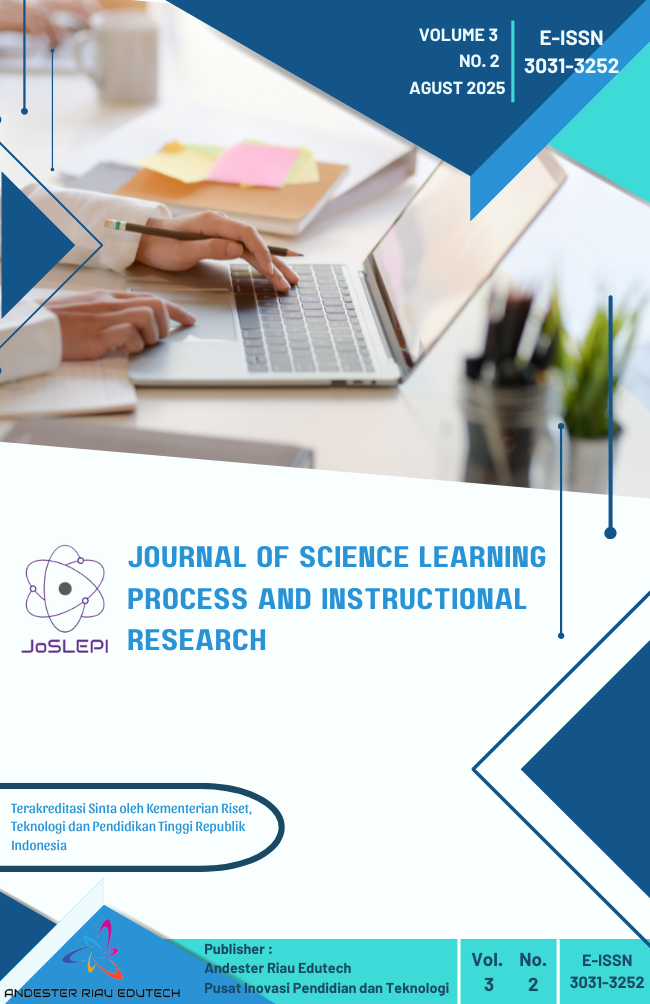Application of Think Pair Share Type Cooperative Learning Model on Students' Cognitive Learning Outcomes in Class VIII Of SMP Negeri 1 Tualang
Keywords:
Think Pair Share, Cognitive Learning Outcomes, Vibrations and WavesAbstract
This study investigates the effectiveness of the Think Pair Share (TPS) type of cooperative learning model in improving students’ cognitive learning outcomes in Class VIII of SMP Negeri 1 Tualang. The primary objectives of this research are to describe the learning outcomes of students taught using the TPS learning model and to compare them with students who were taught through conventional methods. The population of this study consisted of 288 eighth-grade students, with a sample of 64 students determined by a random sampling technique. The research employed a quasi-experimental method with a post-test only control group design to ensure reliable comparisons between the experimental and control groups. The results revealed that the application of the TPS model in the experimental class produced a significant improvement in students’ cognitive outcomes. Students in the experimental group achieved an average cognitive ability score of 85.68, which falls under the very good category. Meanwhile, the control class that received conventional instruction obtained an average score of 68.74, categorized as fairly good. Furthermore, statistical hypothesis testing confirmed that there was a significant difference between the two groups, indicating that the TPS model contributed positively and effectively to students’ cognitive development. The findings of this study highlight that cooperative learning, particularly the TPS model, not only enhances individual student engagement but also promotes collaborative knowledge construction through structured peer interaction. This approach allows students to articulate their ideas, compare solutions, and refine understanding through discussion, thereby strengthening both comprehension and retention of concepts. In contrast, conventional teaching methods were found to limit opportunities for active participation and peer feedback, which in turn hindered optimal cognitive achievement.In conclusion, the application of the Think Pair Share cooperative learning model is proven to significantly improve cognitive learning outcomes among eighth-grade students of SMP Negeri 1 Tualang. The TPS model is recommended as an effective pedagogical strategy for teachers to foster higher student achievement and to encourage more interactive and student-centered learning environments.
Downloads
References
Ahmad. (2016). Tugas, peran, dan fungsi guru dalam pendidikan. c, 88–97.
Alfirahmani, Irawan, D., & Nasir, M. (2025). Development of Android-Based Physics Learning Media to Improve Computer Thinking Skills for High School Students. Journal of Sience Learning Process Aand Instructional Research (JOSLEPI), 3, 1–10.
Amaliyah, N., Fatimah, W., & Abustang, P. B. (2019). Kontribusi Model Pembelajaran Kooperatif Tipe Think Pair Share (Tps) Terhadap Hasil Belajar Ips.SatyaWidya,35(2),126–139. https://doi.org/10.24246/j.sw.2019.v35.i2.p126-139
Anggita Simorangkir, Martina A. Napitupulu, T. S. (2020). Jurnal Pelita Pendidikan. Jurnal Pelita Pendidikan, 8(1), 52–61. https://jurnal.unimed.ac.id/2012/index.php/pelita/article/view/17301/13178
Astuti, F. (2021). Analisis Ranah Kognitif Taksonomi Bloom Revisi pada Soal Ujian Sekolah Bahasa Jawa. Piwulang : Jurnal Pendidikan Bahasa Jawa, 9(1), 83–99. https://doi.org/10.15294/piwulang.v9i1.47031
Chrisdiyanto, E., & Hamdi, S. (2023). Efektivitas Problem Based Learning dan Problem Solving terhadap kemampuan berpikir kritis dan kemandirian belajar matematika. Jurnal Riset Pendidikan Matematika, 10(2), 165–174. https://doi.org/10.21831/jrpm.v10i2.65754
Fajria, S., Azhar, & Nasir, M. (2025). Application of Scientific Approach Assisted by Baamboozle to Improve Cognitive Learning Outcomes On Substance Pressure Material for Class VIII SMP. Journal of Science, Learning Process and Instructional Research, 3(1), 18–25. https://journal.riau-edutech.com/index.php/joslepi/article/view/99
Ikhsan, K. Z. Z. P. R. (2025). Implementation of a Simulation-Based Learning Model Using PHET to Improve Learning Outcomes for Class IX MTsN 1 Kuantan Singingi. Journal of Educational Sciences, 5(4), 715–723.
Lukum, A. (2015). Evaluasi Program Pembelajaran Ipa Smp Menggunakan Model Countenance Stake. Jurnal Penelitian Dan Evaluasi Pendidikan, 19(1), 25–37. https://doi.org/10.21831/pep.v19i1.4552
Maknun, D. L., Irawan, D., & Azhar. (2025). Implementation of the Nearpod-Assisted CORE Learning Model to Improve Students ’ Understanding of Class VII SMP Negeri 20 Pekanbaru ’ s Concepts on Motion and Force Material. Journal of Science: Learning Process and Instructional Research (JoSLEPI), 3(1), 42–49.
Pristiwanti, D., Badariah, B., Hidayat, S., & Dewi, S. R. (2022). Pengertian Pendidikan. 4, 1–5.
Rianingsih, D., Mawardi, M., & Wardani, K. W. (2019). Penerapan Model Pembelajaran Tps (Think Pair Share) Dalam Rangka Meningkatkan Keterampilan Komunikasi Siswa Kelas 3. NATURALISTIC : Jurnal Kajian Penelitian Pendidikan Dan Pembelajaran, 3(2), 339–346. https://doi.org/10.35568/naturalistic.v3i2.394
Rizal. (2022). Pengembangan Video Pembelajaran Rizal. 16(1), 1–23.
Sugiono. (2017). Metode Penelitian Kuantitatif, Kualitatif, dan R&D (Issue January).
Downloads
Published
How to Cite
Issue
Section
License
Copyright (c) 2025 Oh Kasih, Syahril, Zulhelmi

This work is licensed under a Creative Commons Attribution-ShareAlike 4.0 International License.













